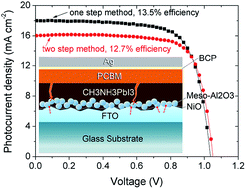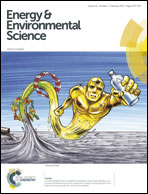Hybrid interfacial layer leads to solid performance improvement of inverted perovskite solar cells†
Abstract
Despite the sky-rocketing efficiencies being reported for perovskite solar cells (PSSCs) with several different configurations recently, it is as yet unclear which configuration will prove beneficial over others. In this work, we report a novel, inverted PSSC with the configuration of FTO/NiO/meso-Al2O3/CH3NH3PbI3/PCBM/BCP/Ag. The first implementation of the hybrid interfacial layer of an ultrathin NiO compact layer (10–20 nm) plus an inert mesoporous Al2O3 (meso-Al2O3) scaffold, featuring high optical transparency and specific dual blocking effect, leads to minimal light absorption loss and interfacial recombination loss. The device performance has been significantly improved with respect to the control PSSCs without the meso-Al2O3 layer. Synchronized improvements in photovoltage, photocurrent and fill factor lead to a high efficiency of >13%, which is the highest reported so far for NiO based PSSCs. Small hysteresis and stable power output under working conditions have been demonstrated for this type of solar cells. The results also highlight the general and critical importance of interfacial control in PSSCs, and their effects on device performance.

- This article is part of the themed collection: 2015 most accessed Energy & Environmental Science articles

 Please wait while we load your content...
Please wait while we load your content...